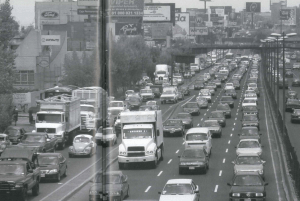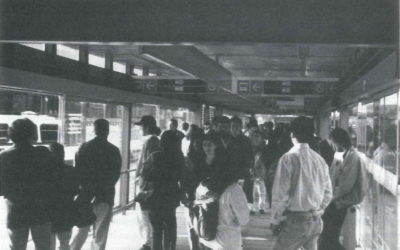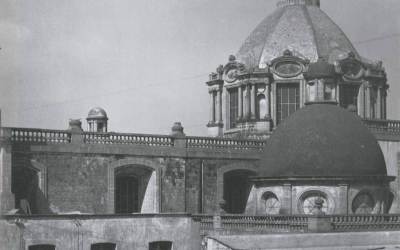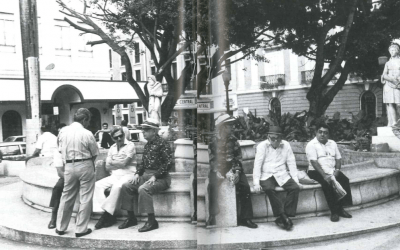Improving Urban Air Quality

Buses, trucks and cars contribute to air pollution daily in Mexico City. Photo by Luisa Molina.
In São Paulo, Santiago de Chile and Mexico City, some days you can hardly breathe the air. Likewise in Los Angeles, Beijing and Bangkok. Rapid population growth, uncontrolled urban expansion, unsustained economic growth, increased energy consumption and increased motorization all translate into serious air pollution problems in cities throughout the world. A persistent and pervasive threat to health, air pollution does more than choke lungs. It also poses a tremendous economic and social cost to society.
Over the past three years a benchmark integrated assessment of air quality in the Mexico City Metropolitan Area (MCMA)⎯one of the world’s largest megacities⎯has been undertaken by a team of Mexican, U.S. and other international scientists and engineers under our leadership. This case study of the Integrated Program on Urban, Regional and Global Air Pollution, a collaborative research and education program initiated at MIT, addresses in a coordinated and interdisciplinary manner the air pollution problems stemming from human activity in megacities. In the area of health, we have collaborated closely with our counterparts at the Harvard School of Public Health.
Mexico City epitomizes the types of environmental problems experienced by megacities around the world and the common obstacles to solving them. Although international attention has focused on global climate issues, most local decision makers do not take into account the relationships between urban, regional and global pollution in addressing the common causes— scientific, economic and social—that underlie these interrelated problems.
Through this integrated assessment approach, we develop recommendations emphasizing the interaction between a wide range of disciplines. The approach requires not just an understanding of the air pollution science but also how to balance economic, social and technological factors, and how to make decisions in the presence of uncertainty and incomplete data.
The Mexico City Program’s researchers have now published a book entitled The Air Quality in the Mexico Megacity: An Integrated Assessment, providing an overview of the current understanding of the air pollution problem, and lessons learned from air quality management programs to date. The book also includes recommendations for research and institutional change so that cost-effective measures can be efficiently developed and implemented. The material presented in the book has provided the foundation for the strategic planning for the new ten-year air quality management program prepared by the Mexican Metropolitan Environmental Commission (Comisión Ambiental Metropolitana or CAM). Some of the recommendations suggested by the Program have already been adopted and implemented by the Mexican authorities.
Air Pollution in the Mexico City Metropolitan Area
The Mexico City Metropolitan Area (MCMA) has undergone rapid population growth and massive transformation in the last century. As the site of the nation’s capital, the MCMA is home to the national political institutions, the greatest concentration of economic investments, and most of the country’s industrial and financial infrastructure. The MCMA has attracted migrants from other parts of the country and stimulated economic growth as the nation began industrialization. The population grew rapidly from 3 million in 1950 to 18 million in 2000, continually occupying land further away from the historic center of the Federal District. In the last half-century alone, the urbanized area of the region has increased more than ten times, from just 45 square miles in 1940 to 580 square miles by 1995. The expansion pushed the city beyond the Federal District and into some municipalities of the State of Mexico and other neighboring states.
The topography and meteorology of the MCMA contribute substantially to the problem of air pollution. The region where the MCMA is located is surrounded by mountains at a subtropical latitude and at high elevation (7350 ft above mean sea level), where thermal inversions are frequent phenomena and high pressure systems tend to “trap” the pollutants in the Valley. More than 18 million inhabitants, more than 3.5 million vehicles, and about 35,000 industries and services coexist in these conditions. Together, these activities consume more than 12 million gallons of fuel per day, producing emissions of thousands of tons of pollutants, which can react in the atmosphere to generate other pollutants that can be more dangerous to health than the original pollutants.
Both the Mexican government and citizens have recognized air pollution as a major social concern since the mid-1980s. In the 1990s, there were successful reductions in the concentrations of some pollutants such as lead, carbon monoxide and sulfur dioxide. Comprehensive air quality management programs were developed and carried out. The monitoring and evaluation of air pollution were improved. The government strengthened and began to enforce a vehicle inspection and maintenance program. Natural gas in industry and the power sector replaced fuel oil. Among other measures, specific actions reduced volatile emission from gasoline stations and storage tanks in industry; as well as removal of lead from gasoline and the implementation of catalytic converters in automobiles. In addition, programs such as “No driving day” (Hoy No Circula) have been effective incentives to modernize the vehicle fleet and to help ensure the proper maintenance of vehicles.
Despite these important gains, air pollution problems remain very serious. Lack of financial resources, as well as lack of information and inadequate follow up, have meant that some measures have not fully been put into practice. MCMA residents remain exposed to unhealthy concentrations of air-borne pollutants, especially particulate matter and ozone, the two most important pollutants from the standpoint of public health.
No single “silver bullet” will fix this tenacious problem. To have a substantial impact, an array of appropriate strategies must be identified and deployed to enhance air quality. Let’s look at some of the key findings of the first phase of the Mexico City Program.
Impacts of Air Pollution
Human health is the major concern over air pollution and the major driving force for policy actions in the MCMA. However, the Program also considers effects of air pollution on ecosystems, as well as the linkage with global warming. Mexico, like other countries in the world, contributes to global warming and is likely to be affected by it.
A health effects sub-team⎯led by the Harvard School of Public Health (HSPH) in collaboration with Mexican scientists from the Environmental Health Office of the Health Ministry and the Autonomous Metropolitan University⎯has assessed health risks posed by current and anticipated levels of air pollution. It has also estimated the economic implications of Mexico City’s air quality. The study focused on exposure to pollutants, mainly very small polluting particulates and ozone. The team found that in 1998 the average population exposure to particulate matter was comparable to those in several of the largest cities in the world (about 90 µg/m3). Studies in various cities around the world, including Mexico City, show a correlation between daily fluctuations in deaths and daily fluctuations in air pollution levels. The findings suggest that one more person out of every hundred would survive every day with just small decreases in air pollution (one for each 10 µg/m3 decrease in levels of PM10). The implication is that such a reduction would reduce premature mortality in the Mexico City area by about 1000 cases. The effect could be several times larger if one considers longer-term responses to particulate matter exposure.
Ozone levels have received much attention in Mexico City, as the one-hour air quality standard of 110 ppb is being exceeded more than 300 days every year. Although the effect on mortality is not as striking as that of particulate matter, ozone has significant effects on respiratory function and on hospital admissions for respiratory conditions such as asthma.
The monetary value of the health benefits expected from air pollution control is difficult to estimate because of the uncertainties assigning monetary values to the reduction of health risks. Most estimates of the monetary value of reductions in mortality risks are derived using estimates of society’s willingness to pay for such improvements. The first study of this kind in Mexico is being conducted as part of the Mexico City Program. Past estimates were extrapolated using values derived from studies conducted in the U.S. and other developed countries.
Transportation Sector
Transportation is a critical enabler of economic activity and beneficial social interactions. Yet, the transport sector is the most important source of pollutants emitted into the MCMA atmosphere in 1998. The growing problems of congestion, accidents, and noise are also very worrisome. The MCMA now faces the challenge of reducing the adverse environmental impacts and other negative effects of transportation without giving up the benefits of mobility. This dilemma becomes most pressing under conditions of rapid urban growth, which is likely to increase travel demand significantly.
As the population has increased and the residential areas have decentralized, patterns of passenger trip mode choice in the MCMA have also shifted dramatically. Currently, the growth of private cars is 6% per year, while usage of metro and buses is decreasing. The road infrastructure lacks peripheral streets. Many vehicles lack basic pollution control devices required by the vehicle inspection program. Despite regulations about maximum vehicle age, the taxi fleet is aging and has ill-maintained emission controls. The diesel truck fleet in Mexico is also severely aging (nearly 30% is 15 years or older) and turns over very slowly. Consequently, the emissions from motor vehicles and traffic congestion have grown considerably.
Although MCMA government authorities have taken major steps to reduce transportation emissions, new measures are needed to resolve the current chaotic situation. The growing need for transportation must be accompanied by incentives to increase turnover rate for vehicle fleet and retrofitting of trucks with emission control devices. Service quality and personal security must be provided to increase use of public transportation. Infrastructure must be developed to allow inter-city truck traffic to bypass downtown Mexico City. New specifications for lower sulfur content in gasoline and diesel should enable the introduction of future cleaner vehicle technologies. In short, a transport policy must be created throughout the entire MCMA that enables mobility with a low level of pollution.
Industrial, Commercial and Residential Sectors
In addition to transport, pollution sources in the MCMA area include power generation; production of goods and services; home and industrial use of fuels and solvents; and the management and distribution of fuels. Soil erosion also emits dust into the atmosphere.
Two power plants, Jorge Luque and Valle de Mexico, provide about 20% of the MCMA’s power requirement. Despite improvements, certain production units are more than 40 years old. Both plants are coming to the end of their life cycle and must be replaced; the new ones should be built outside the Mexico City Valley. At the same time, the MCMA must implement a program for rational consumption of energy with a rate system that would encourage energy conservation.
In recent years, emissions from the industrial sector in the MCMA have tended to decrease, as a result of environmental measures such as shifts to less polluting fuels, the closure or relocation of some industries, and the installations of emission control devices. Large industries, which make up two percent of the industrial establishments in the MCMA, and a fraction of the medium-sized industries, are in general complying with environmental standards. Nevertheless, many medium-sized industries as well as most small and micro industries continue to emit significant amounts of pollutants.
In the commercial sector, hospitals, hotels, sports centers, laundries, paint shops, printing shops, tortilla factories, restaurants and gas stations are important sources of pollutants. The elimination of fuel oil usage at the beginning of the 1990s and the introduction of fuels with low sulfur content have significantly reduced emissions related to combustion processes in the commercial and service sectors. Nevertheless, the use of antiquated equipment that results in significant emission of pollutants still poses a serious problem.
More than five million homes generate atmospheric pollutants through daily activities such as cooking food, heating water, and using appliances and solvents. This sector consumes the majority of liquefied petroleum gas (LPG) sold in the MCMA, as well as small amounts of fuel wood and a growing amount of natural gas and electricity. The MCMA authority is considering substituting LPG with natural gas for home cooking and solar energy for water heating.
Important efforts also need to be made in the informal economy sector. Out of the 7 million economically active people in the MCMA, about 40 percent were classified as being in the informal sector; most of these are selling products or services on the city’s sidewalks and might contribute significantly to emission of pollutants.
Metropolitan Coordination and Citizenship Participation
One of the major obstacles to the implementation of anti-pollution measures in the MCMA is the lack of a powerful metropolitan institutional structure. The Metropolitan Environmental Commission (CAM)⎯an interagency that consists of environmental authorities from the federal government, the State of Mexico and the Federal District⎯was created in 1996 to coordinate the policies and programs that are implemented in the metropolitan area. However, CAM does not have a specific budget for its own operation, nor does it have a defined operative organizational structure. Furthermore, the constant change of personnel according to political winds, its lack of independent budget, and its lack of power to enforce regulations have a negative influence on the functioning of this agency. To ensure continuity in the implementation of long-term action plans, the CAM must be significantly restructured and should be empowered to carry out the planning, integration and implementation of metropolitan environmental policies.
During the design of the new air quality management program, the CAM increased its efforts to encourage public participation and stakeholder input by forming working groups consisting of representatives from academia, NGOs and industries. The Mexico City Program has implemented several activities including annual workshops and symposia, distinguished visiting faculty and scientists at MIT, air quality management courses for professionals, policy makers and environmental leaders from non-governmental organizations, media and industry. The outreach activities currently underway involve stakeholder education and participation. The awareness of the population and the active and informed participation of stakeholders are necessary to ensure public acceptance of pollution control policies.
Next Steps
As the program enters a second phase, field measurement campaigns focus on updating and improving the MCMA emissions inventory, as well as increasing current knowledge of the chemistry, dispersion and transport processes of pollutants. A February 2002 exploratory field measurement campaign utilized state-of-the-art instrumentation such as an aerosol mass spectrometer, tunable diode lasers coupled to long-path absorption cells, a proton-transfer mass spectrometer, and a fine particle monitor that selectively samples soot particles. The field measurement campaign, a joint effort of the MIT Mexico City Program and the CAM, involves the participation of many U.S. and Mexican institutions and agencies. An intensive campaign has been scheduled for Spring 2003. The data obtained from the field measurements will be fed into a regional-scale air pollution model in order to provide a firm scientific foundation for regulatory decision-making to reduce air pollution and human health impacts.
Another activity involves a pilot study of diesel exhaust exposure in the Mexico City area to investigate if the incidence of lung cancer in trucking company employees can be linked to their personal exposures to diesel exhaust. This MIT- Harvard School of Public Health (HSPH) pilot study is an extension of an HSPH project being conducted in clusters of both large and small trucking terminals and related truck routes in many locations throughout the United States, as well as in some terminals in Canada.
A team led by HSPH has been developing a benefit-cost analysis for selected strategies to reduce air pollution in Mexico City. The first strategy under scrutiny is the use of particle traps and low-sulfur fuel for diesel engines, as employed in buses and possibly trucks. The team has developed an analytic framework incorporating capital and operating costs changes in emissions of important pollutants (primary particles, NOx), health effects, and valuation of those effects.
Thus, the Program brings together health, transportation, administration, and many other interdisciplinary approaches to understanding and defeating air pollution. Although we have focused on the Mexico City area, the work carried out under this Program has significance for developing nations generally. Policies to reduce air pollution must be based on the best available scientific knowledge; however, political will and capacity must transform this knowledge into action. What is learned from this Mexico City Case Study will provide insights on the challenges and opportunity facing other megacities of the world.
Related Articles
Bogotá: A City (Almost) Transformed
The sleek red bus zooms out of the station in northern Bogota, a futuristic symbol of an (almost) transformed city. Nearby, thousands of cyclists of all ages enjoy a sunny morning on Latin America’s largest bike-path network.
Editor’s Letter: Cityscapes
I have to confess. I fell passionately, madly, in love at first sight. I was standing on the edge of Bogotá’s National Park, breathing in the rain-washed air laden with the heavy fragrance of eucalyptus trees. I looked up towards the mountains over the red-tiled roofs. And then it happened.
Social Spaces in San Juan
My city, San Juan, is a social city. Its character and virtue are best illustrated and defined by the collective and individual memories of its people and those places where we go to spend time in idleness….




